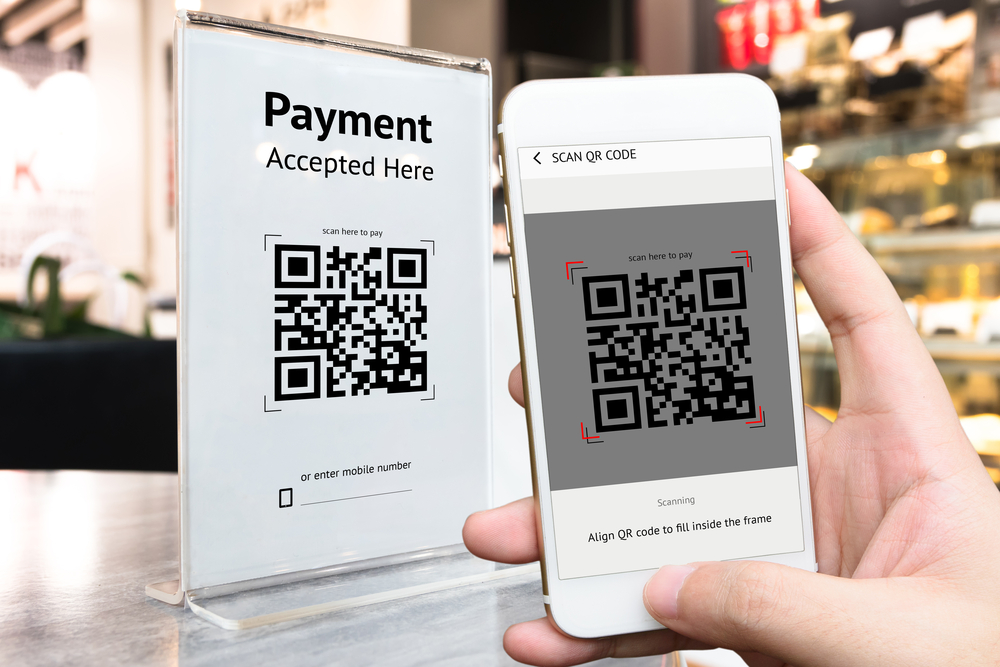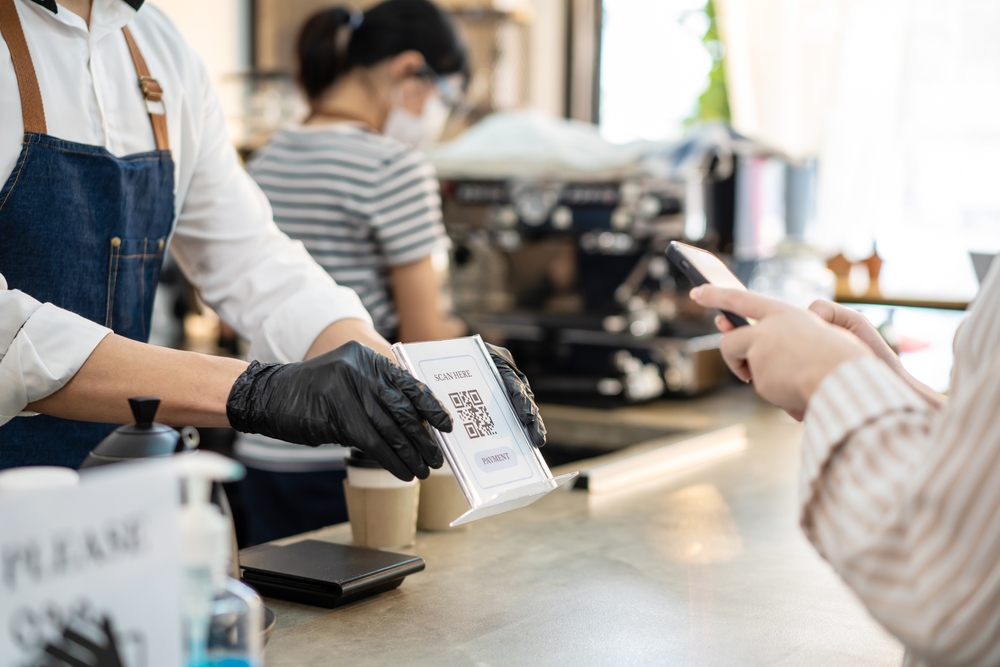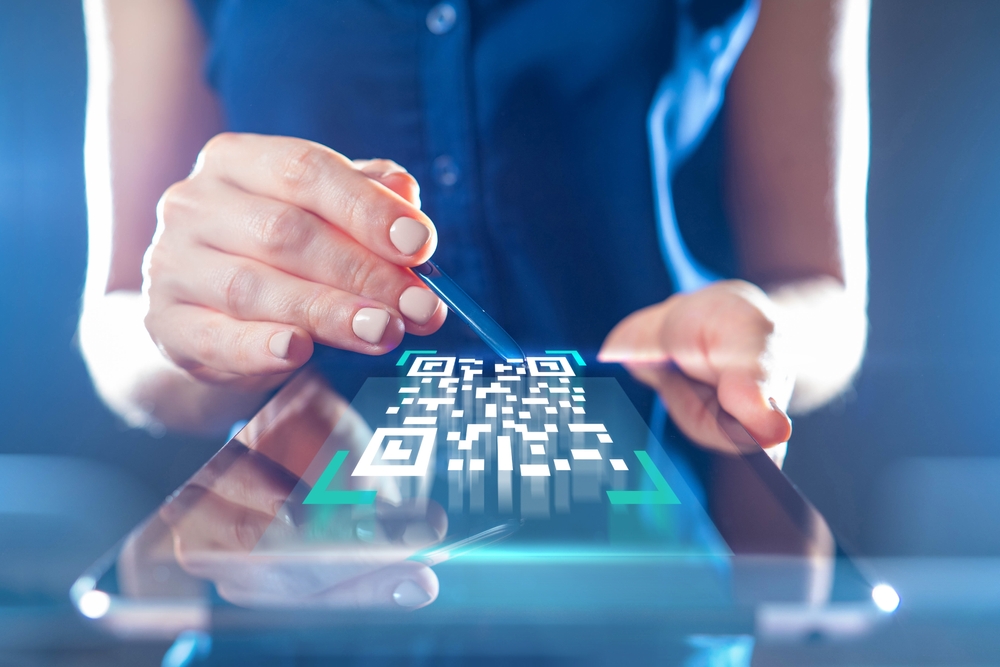QR payments and collections are an alternative form of mobile payment that does not require a card chip or NFC technology: just a camera and an internet connection
Paying by QR is becoming increasingly popular among younger consumers and tourists, and is one of the most in-demand methods, especially for Chinese visitors to Spain. Businesses are adopting this payment method just as they did with bank cards and contactless payments. How can QR payment be included in a business?
What is a QR code and how does it work?
What is a QR code?
A QR code (quick response code) is a two-dimensional (2D) barcode that can store up to 7,089 characters, including letters, numbers and other symbols.
The first QR code system was developed in Japan by the company Denso Wave in 1994 in response to the need to accurately track vehicles and parts during manufacturing.
These codes have a two-dimensional matrix design with three squares in the corners allowing for quick decoding of the information they contain.
And how does it work?
A QR code stores data in a two-dimensional matrix of black and white modules. This data is encoded in the form of 0s and 1s. When a mobile device or QR reader scans the code, the device’s camera captures the image and a specific software interprets it, i.e. it decodes the information quickly, allowing the user to access the content or perform an action associated with the code.
These codes are used in a variety of applications, from advertising and marketing to payments and product identification. To learn more about how financial technologies are integrated into business, you can read this article on open banking.
Types of QR codes
A QR code can store all kinds of text. It can also be used to enter an email, contact details in .VCARD format, postal addresses or passwords for WIFI networks. It is even possible to store an entire game of chess. It has also sometimes been used to generate ‘functional art’. The more data it contains, the denser it is.
Although there are many types of QR code, it being an open standard, the most widespread format is the one seen in this article: A square frame with three squares in the corners that help the scanner orient the code. Generally, the content of QR codes is classified into two types: static and dynamic.
Static QR Codes
Static QR codes have fixed content, that is, the text or URL is fixed, does not change and cannot be modified once generated. These codes store the information directly in the data matrix, which means that when the code is scanned, the same content is always displayed.
A developer generates a static QR code that leads to a PDF file with an installation guide for one of their apps. Once the QR is printed in a physical manual, it will always lead to the same PDF file. If the developer updates the installation guide and needs to distribute the new version, they will need to create and distribute a new QR code.
The advantages of static QR codes include:
- Simplicity: They are easy to generate and do not need any special configuration.
- Cost: They do not require additional services or subscriptions to use.
- Permanence: Once created, they can be printed and distributed without needing to worry about expiration or the need for updates.
Static QR Code Example
An example, to better understand what a static QR code is, would be:
A developer generates a static QR code that leads to a PDF file with an installation guide for one of their apps. Once the QR is printed in a physical manual, it will always lead to the same PDF file. If the developer updates the installation guide and needs to distribute the new version, they will need to create and distribute a new QR code.
Dynamic QR Codes
Dynamic QR codes offer greater flexibility and functionality. Unlike static QRs, dynamic QRs do not store the information directly in the data matrix. Instead, they contain a URL that redirects to a server where the information can be updated without changing the original code.
This allows businesses to modify content without having to reprint or redistribute codes.
The advantages of dynamic QR codes include:
- Versatility: as the information can be modified at any time without changing the physical code, dynamic QR codes can be used for multiple purposes and adapted to different needs.
- Follow-up: they allow the collection of data on the number of scans, location and other analytical details.
- Security: they may include additional security measures such as password protection or expiration dates to control access to information.
Dynamic QR code example
To better understand what a dynamic QR code is, let’s look at this example:
A developer uses a dynamic QR code on their business card, which redirects to their online portfolio. If the developer updates the content of the portfolio or changes its URL, they can simply update the link on the server. The printed QR code is still valid and it will always direct to the latest content without needing to be replaced.
How are QR payments made?

In Japan and China, they have been paying through QR codes for years. It is an intelligent solution for the transmission of information between business and customer. For example, it is possible to communicate via a QR code something as complex as a bank address, a payment protocol, or a link that allows money to be paid. In addition, making payments with QR allows the cash management of a business to be streamlined.
QR code payment is a way to standardise or simplify mobile payment without making use of the classic card chip or an NFC system. The process of using a QR code payment is simple and fast:
- Generate QR: the merchant generates a QR code that contains the necessary information for payment. This can include a fixed amount or allow the user to enter the amount.
- Scan the QR code: the customer uses their mobile phone’s camera to scan the QR code. Most mobile payment apps and banks have this functionality already built in, and when the code is scanned the app decodes the information and displays it on the screen.
- Authorisation: the customer reviews the payment details and authorises the transaction. This step can be entering a PIN, using fingerprint or facial recognition, depending on the security settings of the payment app.
- Payment confirmation: once authorised, the payment is processed and both parties receive a confirmation. The customer sees a confirmation in their payment app with the details of the transaction, such as the amount and payee.
Include QR code payments for businesses
Currently, there are several options for including QR codes in businesses, many of which are embedded in applications or in APIs for mobile payments such as WeChat, PayPal, Bizum or AliPay.
QR payments with Bizum in retailers
At the end of 2021, Bizum announced a new feature for its users: payment with Bizum QR, initially intended to facilitate payment for the Christmas Lottery. Shortly after, Bizum launched a complete payment system through its platform, aimed at payment in State Lotteries and Betting Administrations.
It is now already possible to receive QR payments through Bizum, although it is necessary to use a third-party application such as Pacomet or Monei. These services allow retailers to generate QR codes that include text information about the Bizum system, the amount, the reference and the phone number that will issue or receive the payment.
QR Payments with WeChat Pay
WeChat Pay is the first QR payment service for businesses to arrive in Spain. It is imported from China, where it has been used as a payment system since 2013. In 2018, the Michelin Guide helped introduce these QR payments in Europe. Currently, its use in Spain is still limited, its main users being retailers run by people from China and customers from that country.
QR payments with PayPal
In 2020, PayPal launched a QR payment service for merchants. The mechanics are very simple: the merchant uses PayPal to generate a QR code with a defined amount, and the user uses the PayPal app to scan that code and pay from their PayPal account, making it easy to pay with QR codes.
As only two phones are necessary (one for the business and one for the customer) it is a very good solution for mobile points of sale such as markets, booths, fairs, etc. Payment is made by mobile phone and the receipt is sent to the email address.
QR payments via link
It is also possible to generate a QR through any other web payment system by entering the URL of the payment platform in a free QR generator, such as QR Code Monkey, or by requesting the payment system provider to automatically generate QRs through payment APIs. It is a relatively simple thing offered by many point-of-sale (POS) terminal providers in Spain.

Advantages and disadvantages of QR code payment
QR payments have revolutionised the way of paying in businesses, offering a fast, flexible and secure solution. Here are some of the main advantages of implementing QR payments in a business.
- Speed: paying with QR is an extremely fast process. The QR code generation is almost instantaneous and the customer only needs a few seconds to scan it and enter their credentials. This reduces the waiting time in transactions, improving efficiency for the merchant and for the customer.
- Flexibility: QR codes offer great flexibility in their use. Paying with QR is not limited by
device-specific technology, as most smartphones can scan these codes. In addition, they can be used for payments in physical stores, online purchases and even to pay for services remotely.
- Security for collections: QR payments provide an additional layer of security in transactions as the payment information is encrypted and protects sensitive data from both the customer and the merchant. In addition, being a form of electronic payment, transactions can be monitored in real-time, which helps prevent fraud.
QR payment also has all the advantages of electronic payment. As we have mentioned, it is immediate and very secure, it is possible to acquire goods and services remotely, they enable the creation of a transaction history, they prevent fraud as they are traceable transactions, etc.
On the other hand, one of the biggest criticisms of QR code payment is the lack of security mechanisms for consumers when scanning, since they do not know what they might encounter when scanning the code. Currently, applications already exist to avoid this type of problem, so that if the QR code leads to an unsafe site the applications do not open it.
The future of QR payments
It is interesting to note that while QR code technology reached the age of 30 in 2024, is only now taking off. At least in Spain. The pandemic popularised the scanning of QR codes on menus in restaurants, and contactless payment became equally popular.
QR payment is an alternative way to merge both features, so that it is not necessary to have an NFC phone to make a mobile payment or a physical credit/debit card. Instead, you only need a mobile phone with a functional camera, an internet connection and a secure payment app.
Looking at the trend of use in Japan and then in China, everything seems to point to QR payment playing an important role in the coming years because of how easy it is to pay with this method.
Are you interested in financial APIs? Discover all the APIs we can offer you at BBVA




























